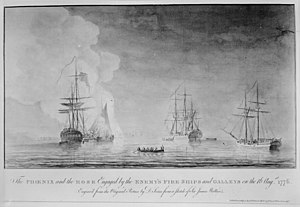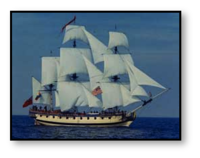
HMS Endeavour was a British Royal Navy research vessel that Lieutenant James Cook commanded to Tahiti, New Zealand and Australia on his first voyage of discovery from 1768 to 1771.

In the 18th century and most of the 19th, a sloop-of-war in the Royal Navy was a warship with a single gun deck that carried up to eighteen guns. The rating system covered all vessels with 20 guns and above; thus, the term sloop-of-war encompassed all the unrated combat vessels, including the very small gun-brigs and cutters. In technical terms, even the more specialised bomb vessels and fireships were classed as sloops-of-war, and in practice these were employed in the sloop role when not carrying out their specialised functions.
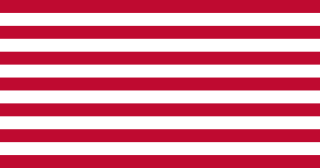
The Continental Navy was the navy of the Thirteen Colonies during the American Revolutionary War. Founded on October 13, 1775, the fleet developed into a relatively substantial force throughout the Revolutionary War, owing partially to the substantial efforts of the Continental Navy's patrons within the Continental Congress. These Congressional Patrons included the likes of John Adams, who served as the Chairman of the Naval Committee until 1776, when Commodore Esek Hopkins received instruction from the Continental Congress to assume command of the force.

Commander Abraham Whipple was an American naval officer best known for his service in the Continental Navy during the Revolutionary War and being one of the founders of Marietta, Ohio. Born near Providence, Colony of Rhode Island, Whipple chose to be a seafarer early in his life and embarked on a career in the lucrative trade with the West Indies, working for Moses and John Brown. In the French and Indian War period, he became a privateersman and commanded privateer Game Cock from 1759 to 1760. In one six-month cruise, he captured 23 French ships.

HMS Surprise is a modern tall ship built at Lunenburg, Nova Scotia, Canada. The vessel was built in 1970 as HMS Rose to a Phil Bolger design based on the original 18th-century British Admiralty drawings of HMS Rose, a 20-gun sixth-rate post ship from 1757.
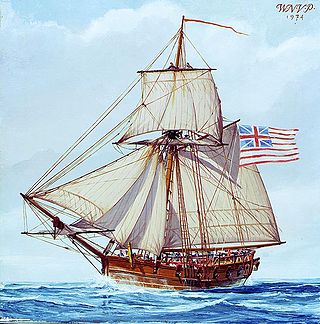
USS Providence was a sloop-of-war in the Continental Navy, originally chartered by the Rhode Island General Assembly as Katy. The ship took part in a number of campaigns during the first half of the American Revolutionary War before being destroyed by her own crew in 1779 to prevent her falling into the hands of the British after the failed Penobscot Expedition.
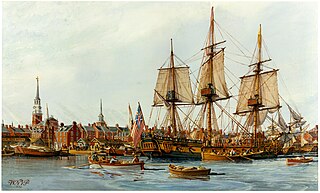
Alfred was the merchant vessel Black Prince, named for Edward, the Black Prince, and launched in 1774. The Continental Navy of what would become the United States Navy acquired her in 1775, renamed her Alfred after 9th century English monarch Alfred the Great, and commissioned her as a warship. She participated in two major actions, the battle of Nassau, and the action of 6 April 1776. The Royal Navy captured her in 1778, took her into service as HMS Alfred, and sold her in 1782. She then became the merchantman Alfred, and sailed between London and Jamaica.

The Battle of the Rice Boats, also called the Battle of Yamacraw Bluff, was a land and naval battle of the American Revolutionary War that took place in and around the Savannah River on the border between the Province of Georgia and the Province of South Carolina on March 2 and 3, 1776. The battle pitted the Patriot militia from Georgia and South Carolina against a small fleet of the Royal Navy.

HMS Drake was a Royal Navy 14-gun ship rigged sloop-of-war with a displacement of 275 tons burthen. Originally named the Royal Oak, she was built in New England in 1775 by John Wharton from Philadelphia. She first sailed between London and Stettin as a tobacco-ship. She was then sold in 1776 and renamed Resolution. Captained by Edward Hawker, the ship traded between London, Boston, and Cork. On 4 March 1777 the British navy purchased her at Plymouth for 3,000 pounds sterling. She completed fitting out as a warship on 24 May 1777. She became the ship-rigged sloop-of-war Drake with either 14, 18 or 20 guns. From July 17, 1777, she served in the American Revolutionary War. Her first mission was protecting the packet-boats between Harwich and Gorée
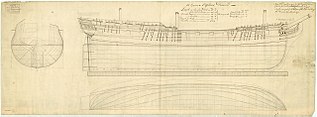
The fourth HMS Diamond was a modified Lowestoffe-class fifth-rate frigate ordered in 1770, launched in 1774, but did not begin service until 1776. Diamond served off the eastern North American coast and shared in the capture at least one brig during the American Revolutionary War. The frigate was paid off in 1779, but returned to service the same year after being coppered. Diamond sailed to the West Indies in 1780, was paid off a final time in 1783 and sold in 1784.

HMS Lively was a 20-gun post ship of the Royal Navy, launched in 1756. During the Seven Years' War she captured several vessels, most notably the French corvette Valeur in 1760. She then served during the American Revolutionary War, where she helped initiate the Battle of Bunker Hill. The French captured her in 1778, but the British recaptured her in 1781. She was sold in 1784.

The Massachusetts Naval Militia, was a naval militia active during the American Revolutionary War. It was founded December 29, 1775, to defend the interests of Massachusetts during the war.

HMS Lark was a 32-gun Richmond-class frigate fifth-rate frigate of the Royal Navy. She was launched in 1762 and destroyed in Narragansett Bay in 1778, during the American Revolutionary War.

American colonial marines were various naval infantry units which served during the Revolutionary War on the Patriot side. After the conflict broke out in 1775, nine of the rebelling Thirteen Colonies established state navies to carry out naval operations. Accordingly, several marine units were raised to serve as an infantry component aboard the ships of these navies. The marines, along with the navies they served in, were intended initially as a stopgap measure to provide the Patriots with naval capabilities before the Continental Navy reached a significant level of strength. After its establishment, state navies, and the marines serving in them, participated in several operations alongside the Continental Navy and its marines.

The Rhode Island State Navy was the first colonial or state navy established after the American Revolutionary War began in April 1775 with the Battles of Lexington and Concord. On the following June 15, the General Assembly authorized the acquisition of two ships for the purpose of defending the colony's trade. The state's ships were generally used for defensive operations within Narragansett Bay, although some prizes were taken. The state was also one of the first to authorize privateering.
HMS Canceaux was a sloop active in both the hydrographic exploration of the Atlantic Canada and New England coastline and in the American Revolutionary War. She played an integral role in the battle for control of Maine, in particular at the Burning of Falmouth. She began her life as a merchant vessel and would eventually be transformed to a military vessel for the Royal Navy, equipped to command the razing of major settlements. After leaving the Saint Lawrence River estuary in 1771, Canceaux actively shaped the maritime history of the American Revolution.
Henry Mowat (1734–1798) was an officer of the Royal Navy commanding ships in northern New England during the American Revolutionary War. He was the son of Captain Patrick Mowat of the post ship HMS Dolphin. He was born in Scotland and went to sea at the age of 18.

HMS Kingfisher was the second ship in the 14-gun Swan class of ship sloops, to which design 25 vessels were built in the 1760s and 1770s. She was launched on 13 July 1770 at Chatham Dockyard, and completed there on 21 November 1770. She took part in the American Revolutionary War, enforcing the blockade of the Delaware Bay, and served in the Battle of Turtle Gut Inlet, near Cape May, New Jersey. While under the temporary command of Lieutenant Hugh Christian, she was burnt by her own crew to avoid capture on 7 August 1778 in Narragansett Bay during the Battle of Rhode Island.
Two vessels of the Royal Navy have borne the name, HM galley Pigot. Both were acquired in 1778 during the American Revolutionary War, and both were lost that year; her crew destroyed the first to avoid her capture, and the Americans captured the second. Both were named for General Sir Robert Pigot, the general commanding the British Army at Newport, Rhode Island, during their service there.

HMS Roebuck was a fifth-rate ship of the Royal Navy which served in the American and French Revolutionary Wars. Designed in 1769 by Sir Thomas Slade to operate in the shallower waters of North America, she joined Lord Howe's squadron towards the end of 1775 and took part in operations against New York the following year. She engaged the American gun batteries at Red Hook during the Battle of Long Island in August 1776, and forced a passage up the Hudson River in October. On 25 August 1777, Roebuck escorted troopships to Turkey Point, Maryland, where an army was landed for an assault on Philadelphia. She was again called upon to accompany troopships in December 1779, this time for an attack on Charleston. When the ships-of-the-line, which were too large to enter the harbour, were sent back to New York, Admiral Marriot Arbuthnot made Roebuck his flagship. She was, therefore, at the front of the attack, leading the British squadron across the shoal to engage Fort Moultrie and the American ships beyond.
